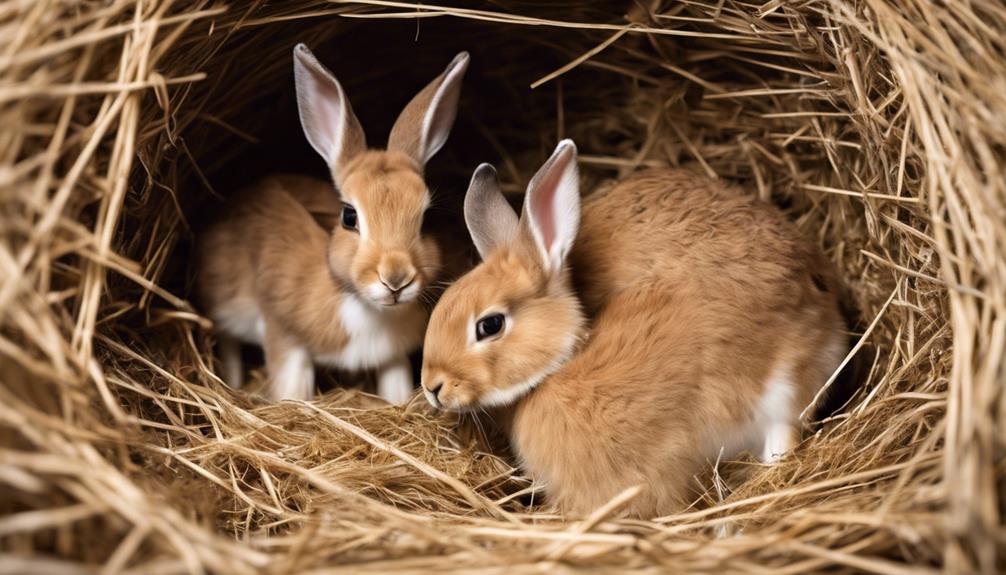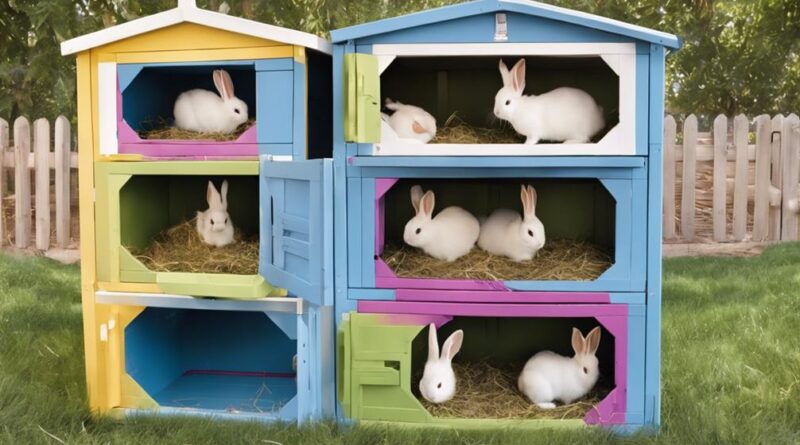What Is the Basic Guide for Breeding Rabbits?
When it comes to breeding rabbits, the process can seem both straightforward and complex. You may wonder how to navigate the nuances of selecting the right breeding stock and providing suitable housing. Understanding the intricacies of rabbit reproduction is crucial, but what about handling unexpected breeding challenges that may arise?
Careful attention to the needs of pregnant does and the subsequent care of kits is essential for a successful breeding program. And let's not forget about the crucial stage of weaning and what lies beyond for your growing rabbitry.
Rabbit Breeding Basics
To begin breeding rabbits successfully, understand the basics of rabbit reproduction. When it comes to breeding techniques, there are a few key methods to consider. One common technique is known as 'cage mating,' where you introduce the male rabbit into the female's cage for breeding. This method allows for controlled breeding and easy monitoring of the mating process. Another technique is called 'pasture mating,' which involves placing the male and female rabbits in a larger, open area to mate naturally. This technique mimics the rabbits' natural habitat and behaviors, but it may be harder to monitor and control.
In terms of breeding schedules, it's crucial to be aware of the female rabbit's reproductive cycle. Female rabbits are induced ovulators, meaning they ovulate in response to mating. It's essential to keep track of the female's cycle to determine the best time for breeding. Generally, female rabbits are receptive to mating every 16-18 days, so it's important to wait for the right time to maximize breeding success. Additionally, it's recommended to limit breeding sessions to avoid stressing the rabbits and ensure the health of the offspring.
Selecting Breeding Stock
When choosing breeding stock, prioritize selecting rabbits with desirable genetic traits and good health. This is crucial as the genetic makeup of the breeding pairs will significantly impact the quality of the offspring they produce. Here are four key points to consider when selecting breeding stock:
- Genetics Selection: Look for rabbits with strong genetic backgrounds, free from hereditary diseases or defects. Select breeding pairs that complement each other in terms of desired traits like size, fur type, color, and temperament to improve the chances of producing high-quality offspring.
- Health Checks: Before breeding, ensure that both rabbits are in optimal health. Conduct thorough health checks to rule out any underlying health issues that could affect the breeding process or be passed on to the offspring.
- Fertility Testing: To maximize breeding success, it's essential to confirm the fertility of both rabbits. Fertility testing can help identify any potential issues that may hinder successful mating and conception.
- Overall Vigor: Choose breeding stock that exhibits vitality and vigor. Rabbits that are lively, active, and well-nourished are more likely to produce healthy offspring with robust immune systems.
Housing and Nesting Needs
Consider the space and nesting requirements for your breeding rabbits to ensure their comfort and safety. When setting up housing for your rabbits, provide a secure and spacious environment that allows for movement. Each rabbit should have at least 5 square feet of space, with additional room for nesting areas. For nesting materials, use soft hay or straw to create a cozy spot for the pregnant rabbit to give birth. Ensure the nesting area is secluded to provide the doe with privacy during the birthing process.
Maintaining the right temperature and ventilation is crucial in rabbit housing. Keep the temperature between 50-78°F (10-25°C) to prevent heat stress or cold-related illnesses. Proper ventilation is essential to prevent the buildup of harmful gases like ammonia, which can impact the health of the rabbits. Regularly clean the housing area to ensure a healthy living environment for your breeding rabbits.
Understanding Rabbit Reproduction
Start by learning about the reproductive cycle of rabbits to effectively breed them. Understanding rabbit reproduction involves grasping their reproductive cycles, mating behaviors, genetic health, and lineage tracking.
Here are four key points to consider:
- Reproductive Cycles: Female rabbits (does) have a regular reproductive cycle, typically lasting between 16 to 18 days. It's crucial to track this cycle to determine the best time for breeding.
- Mating Behaviors: Rabbits exhibit unique mating behaviors, including nesting, territorial marking, and courtship rituals. Observing these behaviors can help you identify when rabbits are ready to mate.
- Genetic Health: Before breeding rabbits, it's essential to assess the genetic health of both the male (buck) and female rabbits. Breeding unhealthy rabbits can lead to offspring with genetic issues.
- Lineage Tracking: Keeping track of the lineage of your rabbits is vital for maintaining and improving desirable traits. Record information about each rabbit's lineage to make informed breeding decisions.
Handling Breeding Challenges
To effectively navigate breeding challenges, focus on understanding common obstacles and implementing strategic solutions. Genetic diversity plays a crucial role in successful rabbit breeding. Maintaining a diverse gene pool helps prevent inbreeding, which can lead to health issues and reduced fertility in offspring. When selecting rabbits for breeding, prioritize genetic diversity to ensure the overall health and vigor of future generations.
Another key aspect to consider is the breeding season and timing. Rabbits are known for their prolific breeding capabilities, but it's important to be mindful of the optimal timing for successful mating. Understanding the reproductive cycles of rabbits and the ideal breeding season can increase the chances of a successful breeding outcome.
Additionally, monitoring the health of breeding rabbits is essential to address any potential issues that may arise during the breeding process. Regular health check-ups, proper nutrition, and a clean living environment are all vital components of ensuring the well-being of breeding rabbits.
Care of Pregnant Does
During pregnancy, ensure pregnant does receive proper care to support their health and the development of their offspring. Here are some essential tips to help you provide the best care for your pregnant does:
- Nutrition Requirements: Feed your pregnant does a diet rich in nutrients such as hay, fresh vegetables, and a balanced commercial rabbit pellet to support the growth of the offspring. Ensure they've access to fresh water at all times.
- Health Monitoring: Keep a close eye on the pregnant does' health during this crucial time. Schedule regular check-ups with a veterinarian to ensure they're in good health and address any concerns promptly.
- Exercise Needs: While pregnant, does should still have access to exercise to maintain their muscle tone and overall health. Provide them with enough space to move around freely but avoid stressing them with excessive physical activity.
- Nesting Behavior: As the pregnancy progresses, the does will exhibit nesting behaviors to prepare for the birth of their kits. Provide them with suitable nesting materials like hay or straw to build a comfortable nest for the arrival of the offspring.
Birthing and Care of Kits

As your pregnant does near their due date, preparing for the birthing process and the care of the newborn kits becomes essential for their well-being and growth. When the kits are born, it's crucial to provide a warm and safe environment for them to thrive. Ensure that the nesting area is clean, dry, and well-insulated to protect the newborns from the cold. Monitor the doe and her litter regularly to check for any signs of distress or health issues.
Kit development is a rapid process, and they rely on their mother's milk for proper growth and nutrition. The feeding schedule for kits involves them nursing from their mother multiple times a day. The mother's milk is rich in nutrients that are vital for the kits' development during the first few weeks of their lives. Make sure the doe has access to a balanced diet to support her milk production and the growth of the kits.
During this time, handle the kits with care and gentleness to avoid causing stress to the mother or the newborns. Keep track of the kits' progress by monitoring their weight gain and overall health. If you notice any abnormalities or concerns, consult a veterinarian for guidance. By providing a nurturing environment and following a proper feeding schedule, you can promote healthy kit development and ensure the well-being of your rabbit family.
Weaning and Beyond
When weaning rabbit kits, gradually introduce solid foods to their diet to transition them from solely nursing to independent feeding. This crucial phase sets the foundation for their growth and development.
Here's what you need to know:
- Feeding Requirements: As you begin weaning the kits, provide them with high-quality hay, pellets, and fresh vegetables. Slowly reduce their dependence on milk to encourage them to eat solid foods. Monitor their weight to ensure they're adjusting well to the new diet.
- Health Checks: Keep a close eye on the kits during the weaning process. Check for any signs of illness or digestive issues. Ensure they've access to clean water at all times and maintain a clean living environment to prevent health problems.
- Socialization: Encourage interaction with the kits to promote socialization and reduce stress. Handle them gently and spend time with each kit daily to build trust and familiarity. This will help them become more comfortable around humans as they grow.
- Behavior Training: Start basic training early on to establish good behavior habits. Use positive reinforcement techniques to reward desired behaviors such as using the litter box. Consistent training will help the kits grow into well-behaved adult rabbits.
Frequently Asked Questions
How Can I Tell if My Doe Is Pregnant Without Taking Her to a Veterinarian?
If you suspect your doe is pregnant, look out for signs like nesting behavior, weight gain, and nipple development.
You can also gently feel her abdomen for any signs of pregnancy through abdominal palpation.
What Are Some Common Health Issues That Can Arise During the Breeding Process?
When breeding rabbits, you may encounter challenges like failed matings or complications during birth. To prevent breeding issues, ensure rabbits are healthy, provide proper nutrition, and monitor their behavior closely.
Common health concerns during breeding include uterine infections or mastitis. Prompt treatment with antibiotics and proper care can help manage these conditions.
Regularly consulting with a veterinarian and keeping a clean environment can also prevent health issues during the breeding process.
Are There Any Specific Dietary Requirements for Pregnant Does or Nursing Mothers?
During pregnancy and nursing, your doe has increased nutritional needs for proper growth and milk production. Make sure she gains weight steadily by providing a balanced diet.
Consider supplement options like alfalfa hay or specific rabbit pellets to support her health. Follow a consistent feeding schedule to ensure she gets the necessary nutrients.
This approach helps pregnant and nursing rabbits stay strong and healthy throughout these critical stages.
How Can I Ensure the Survival of All the Kits After Birth?
To ensure the survival of all the kits after birth, pay attention to nesting behavior and the weaning process. Monitor litter size and provide appropriate care.
Handle the kits with care using gentle techniques. Keep the nest clean and warm.
Make sure the mother rabbit is healthy and well-fed to support the growth of the kits. By being attentive and proactive, you can increase the chances of all the kits surviving and thriving.
At What Age Should I Separate the Kits From Their Mother?
When separating the kits from their mother, consider waiting until they reach the appropriate weaning age for better bonding and socialization.
Handle the kits gently to reduce stress during the transition.
Gradually introduce them to solid food while still providing access to their mother for nursing.
Conclusion
Now that you have learned the basics of breeding rabbits, you're ready to start your own breeding program.
Remember to carefully select your breeding stock, provide proper housing and nesting needs, understand rabbit reproduction, and handle any breeding challenges that may arise.
With proper care and attention, you can successfully breed rabbits and enjoy the rewarding experience of raising healthy kits.
Good luck on your rabbit breeding journey!
